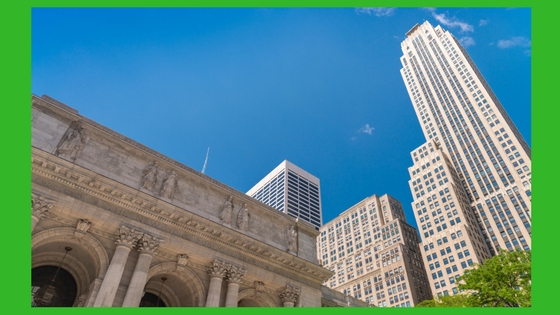Living in the Library

John Fedeler had a better deal than most superintendents. He was the first super for the New York Public Library Main Branch, the famous Schwarzman Building on Fifth Avenue at 42nd St. His son, John Jr., was the second. Their job, like that of many superintendents, required them to live onsite—in a Beaux-Arts building made entirely of marble and brick that spanned half a city block in Midtown Manhattan—in order to be available twenty-four hours a day. Their backyard was Bryant Park.[1]
The Fedelers weren’t the only ones who didn’t have to pay attention to their library’s closing hours. Superintendent Patrick Thornberry and his family lived in the New York Society Library, a private Upper East Side library on 79th St. near Madison Avenue. While they weren’t directly attached to a park like the Fedelers, their apartment came with a penthouse-level garden and was only one block from Central Park. And if they saw something they liked while thumbing through an art book, they might be able to find it at the Metropolitan Museum of Art, also one block away. The Thornberrys must have thought they had a good deal and lived in the library for twenty-two years.[2]
It goes without saying that, at both these libraries, the superintendents’ and their families had access to the stacks twenty-four hours a day, so finding a book wouldn’t have been a problem. But lest we fantasize too much about these unbelievable apartments and their unique amenities, let’s remember that there were downsides. If you’re in a garage band and really need the practice, this probably isn’t the ideal living environment. In fact, John Fedeler, Jr. explained in a New York Times article that “singing and stomping were strictly forbidden in his home until all library staff had gone home for the evening.”[3] Getting shushed by a librarian in your own home would be just too much to bear!
Sadly, neither apartment currently has residents, not even via Airbnb. The New York Society Library’s apartment is used for closed stacks,[4] while the Schwarzman’s apartment was divided up for many uses after it was no longer tenable. The kitchen became a mimeograph room, the switchboard moved into one of the bedrooms, and other rooms became bathrooms or smoking rooms.[5]
Looking for your own library home?
Despite the current dearth of apartments hidden behind rare book rooms, if living in a library sounds like your dream come true (and assuming your band is on hiatus between tours), it needn’t be completely dashed. You could move into an apartment building built along with a library, like at the Delridge Branch of the Seattle Public Library. According to their website, “The new building was developed in partnership with the Delridge Neighborhoods Development Association. The branch anchors the first floor of a three-story building that includes 19 apartments on the top two floors.”[6]
There’s a similar operation in San Francisco’s Glen Park Neighborhood, where the Glen Park Marketplace contains the Glen Park Branch of the San Francisco Public Library system, a grocery store, and fifteen residential condominiums in one building.[7]
Library complexes are popping up all over. The University Dale Apartment complex in St. Paul, Minn., “consists of 92 apartment homes and six brown stone townhomes at the intersection of Dale Street and Aurora Avenue in St. Paul, above the Rondo Community Outreach Library.”[8] No small library, Rondo has impressive community amenities like a homework center, electronic classrooms, and meeting rooms. It also houses two special collections, the Black Culture and History and Immigrant and Refugee Battered Women’s Task Force collections. [9]
More than a place to live
If these complexes represent a growing trend, it’s not just that cities are trying new ways to mix space. These buildings tacitly operate as public/private partnerships and represent libraries’ continued importance. Libraries are first and foremost community services and must be in the communities they serve. A library couldn’t possibly get closer than by being physically attached to the housing of residents. These buildings, not just through their location but through their very architecture, say, “We are part of your community. You are part of us.” In an era when many library services have been transferred online, there may be no stronger statement a library can make.
As awesome as the Fedeler’s and Thronberry’s apartments were, they were still restricted to library superintendents and their families. In many ways those apartments were cut off from their community. Public apartments or condos built along with libraries have the opportunity to be more. So if living in a library suits you, know that you have options, and if there’s not a development like this in your area, hopefully the trend will continue.
References
[1] Cate Etherington, “Life Behind the Stacks: The Secret Apartments of New York Libraries,” 6SqFt, July 3, 2016.
[2] Ibid.
[3] Meyer Berger, “Engineer To Quit Old Library Home,” New York Times, June 20, 1949.
[4] Cate Etherington, “Life Behind the Stacks: The Secret Apartments of New York Libraries.”
[5] Meyer Berger, “Engineer To Quit Old Library Home.”
[6] “About the Delridge Branch,” Seattle Public Library, accessed July 29, 2016.
[7] “Glen Park Marketplace at 2815 Diamond Street,” San Francisco Modern Residential Real Estate, accessed July 29, 2016.
[8] “University Dale Apartments in St. Paul MN,” Real Estate Equities Living, July 29, 2016.
[9] “Rondo,” St. Paul Public Library, accessed July 29, 2016.
Tags: library homes, living at the library, New York Public Library, nypl












